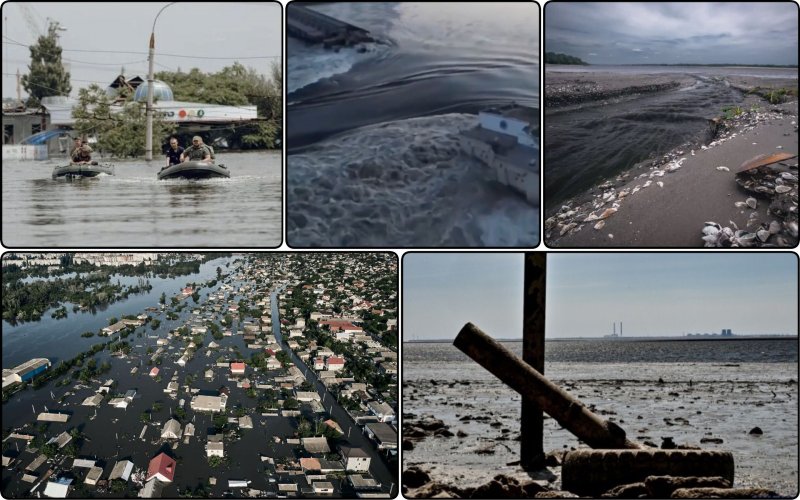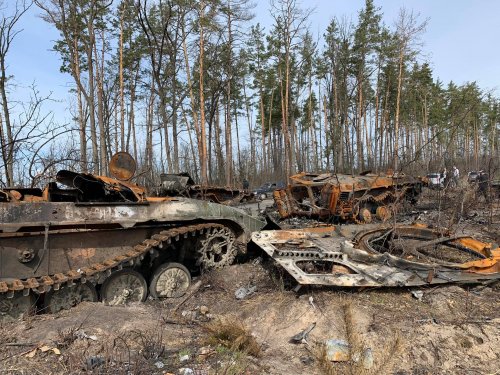More than two weeks have passed since the Russian troops blew up the Kakhovskaya HPP dam and actually destroyed one of Ukraine's six reservoirs. A few hours after the explosion, villages and towns on the banks of the Dnieper downstream began to go under water. Now the water is slowly receding. Soon the Dnipro will return to its usual course, and most of the residents of the flooded areas will be able to return to their homes. But not everything will be as before. After the destruction of the dam, the Kakhov reservoir, as an ecosystem, simply ceased to exist. And such radical changes cannot pass without a trace.
EcoPolitic spoke with Maksym Soroka, head of the ecomonitoring committee of the PAEW Association of Environmental Professionals, about the complex environmental consequences of the disaster at the HPP.
- The undermining of the Kakhovska dam by the Russians was immediately dubbed the biggest man-made disaster of the 21st century. Do you agree with this assessment of the scale of the accident?
On the first day of the disaster, in a commentary for the Financial Times, I compared the Kakhovskaya HPP disaster with the Chernobyl disaster. The further we delve into the problem, move away from civil consequences (consequences of flooding, inundation), the deeper we understand the ecological consequences of the disappearance of the reservoir and all the secondary consequences: for the environment, the economy, all spheres of sustainable development in Ukraine, the more I am convinced that this my assessment was correct. Of course, the consequences of the Kakhovskaya HPP disaster are different, but the long-term impact on the territory, socio-economic development, health and well-being of the population will be the same. On the first day of the disaster, headlines with such characteristics of the tragedy were more emotional. But at the moment, we can already estimate numerically that this is the biggest environmental man-made disaster since the time of the Chernobyl disaster on the territory of Europe. In the future, the cascading effect in ecosystems will increase and the consequences will be felt in 5-10 years.
- The analogy with the Chernobyl disaster is clear here, but according to more practical manifestations, were there similar disasters in the world?
The consequences of the destruction of the hydroelectric power plant are closer to the Aral Sea disaster (loss of 90% of the water volume of the sea due to improper water withdrawal for irrigation, Ed.). After all, not only the ecosystem of the Kakhovsky Reservoir has changed, but also all the ecosystems that have adapted to it over 70 years. Therefore, the situation here is similar in socio-economic, technological, resource, and environmental terms. It is also possible to draw parallels with the draining of swamps during large-scale land reclamation in the Volyn, Rivne regions and southern Belarus during the Soviet Union. There, they also artificially drained the proles and changed the ecosystems. The consequences are felt even now.
Biological filter of waste from Kyiv and Zaporizhzhia
- What are the possible consequences of the hydroelectric power plant disaster that we do not see yet, but will see in the near and distant future?
Under the pessimistic scenario, we will not be able to recreate, even partially, the Kakhov reservoir in the next 5 years. As a result, we will already have: desertification, lowering of the groundwater level, local dust storms and local pollution, local climate changes, changes in the socio-economic development of a huge number of territories of Dnipropetrovsk, Kherson and Zaporizhzhia regions, problems with drinking water supply, deterioration of water quality and, accordingly deterioration of public health (in the above-mentioned regions and the Mykolaiv region). From purely ecological points, several particularly valuable natural protected areas will disappear. For example, Kamianska Sich. This reserve no longer exists, because its ecosystem directly depended on the level of the reservoir and was fed by it. In addition, the anthropogenic and technogenic load on other regions will increase. For example, the other day, the Ministry of Agrarian Policy appealed to farmers with a proposal to redistribute and increase the cultivation of vegetable crops in the territories where there are still reservoirs (the upper and middle cascades of the Dnipro). These are, accordingly, new costs. Also, our team has already received preliminary results that indicate that we will have massive secondary pollution.
- What does the secondary pollution you mentioned involve?
All treatment facilities in this area and higher up the cascade were designed for a certain volume of active water in the Kakhovsky Reservoir. It was a huge biological filter of all waste from Kyiv to Zaporizhzhia. Interestingly, although Zaporizhzhia takes water from the Zaporizhia Reservoir above the dam, it discharges wastewater into the former Kakhov Reservoir. The water was in this reservoir for several months, or in the case of a hydrological drought, for six months before discharge, so it could undergo further purification. Now there is no Kahovsky Reservoir. Accordingly, there is no way to dilute the wastewater and treat it further. As a result, all this polluted mass rushes into the lower cascade and the Black Sea. The Ministry of Environment already records an increase in nitrites in water. And this is the first sign that there is a change in her natural self-cleansing.
- And what will the Dnipro itself look like in the future, starting from the area of the former Kakhov reservoir and downstream?
If we are talking about the territory of the lower cascade, after the reservoir, then there will be no significant changes there. The water will recede, the ecosystem will be able to recover. It will be very difficult for her due to the silt pollution and the presence of pollutants in the water, but she will survive. If we are talking about the former Kakhov reservoir, then, of course, the Dnipro River will not disappear anywhere and the entire reservoir will not be destroyed. A little dam is still left and it will hold water (5 meters are now predicted). But very little. The reservoir will overheat in the summer and "bloom". In winter, it will freeze. The river Dnieper, which we see on old maps, will not be there either. Partial remains of the reservoir and several isolated lakes remain, which will later turn into swamps. The dried bottom will become desolate and, accordingly, the wind will regularly raise dust storms. In 10 years, if nothing is done, nature will gradually take its course and recover. Silt and bottom sediments will be transformed into soils through aerobic processes. And then the soil will be planted with appropriate plants, biodiversity will change. But it will take decades.
Instead of the Veliky Lug – a rotting swamp
- Some of your colleagues are talking about the possible restoration of Veliky Lug (the area of river floodplains flooded during the construction of the hydroelectric power station). Do you think this is possible?
I understand the dream of some colleagues about the Great Meadow. As an environmentalist, I too would like to return to this highly productive ecosystem. But this will not happen. At one time, its flooding was a one-way ticket. Kakhov reservoir, unfortunately, will not turn into the Great Ukrainian Meadow, as everyone dreams, but into a big rotting Ukrainian swamp. As a result, there will be removal of nitrogen and phosphorus from the layer of bottom sediments, along with heavy metals and everything that is there.
- That is, even if the ecosystem is restored, it will not be of the same quality?
Significant changes in ecosystems are always irreversible. In environmental sciences, there is a concept of succession (sequential change of one biocenosis by another, – Ed.). And no matter what we do, we cannot return to the same state. Yes, we can get some other ecosystem in this area. Maybe she will have similar qualities, maybe not. Maybe we will like the new ecosystem, maybe not. At one time, we forced nature to adapt to our whims. Unfortunately, due to the actions of Russian terrorists, we have to adapt to the new circumstances of nature. That's why it's an environmental disaster.
The animal composition of the Dnipro will change by 100%
- We talked about the Dnieper riverbed and the surrounding area, but what about the water in the Dnieper itself?
Theoretically, we expect that due to such a drastic change, biogenic elements will be carried downstream. These are primarily carbon, nitrogen and phosphorus. Accordingly, there will be pollution of the Dnipro water below the dam. Above the dam, it will be the same as it was. Unfortunately, our researchers have not yet been allowed to take measurements in the lower cascade. We hope that by the end of the summer we will be given permission to conduct independent monitoring.
- Is it possible to predict how quickly the water will return to normal?
The lack of information does not allow to properly make calculations and forecasts. The problem is that the state monitoring system is currently not working. As a result of the occupation, the main laboratories of the region were destroyed. The largest water laboratory was located in the still occupied Kakhovka, so there is now an objective lack of data. The state carries out certain monitoring, but its results are not shared with the expert environment. Journalists and our local activists were able to semi-legally collect and transport water samples, but this is a paradoxical situation. I remember how at the beginning of the occupation, we activists secretly took water samples from Mariupol and Berdyansk. And I don't quite understand why such a situation is now taking place in the de-occupied territories. We are currently preparing for an expedition and trying to get permission. There will be data – it will be possible to make realistic forecasts. With similar pollution in the world (Mexico's experience), the ecosystem was cleaned in 3rd place, however, in other climatic conditions.
- Will changes in the Dnipro's biodiversity in these areas depend on the level of pollution?
No, the animal composition will already change 100% and it is not related to pollution. Kakhov reservoir is an artificial ecosystem, but nature has adapted to this ecosystem over many years and the reservoir has become a huge food base: for birds, for fish, for reptiles, for reptiles, for amphibians, for insects. The water reservoir has disappeared, the animal habitats and, accordingly, the food base have disappeared. Therefore, species diversity will decrease and this is an irreversible process. As a result, the ichthyofauna will suffer. If just tomorrow we could restore the Kakhov reservoir, then the period of reproduction is predicted to be 4 years.
There is no threat to the entire Black Sea
- Let's move on to the situation with the Black Sea, we can already see that everything that was carried away by the water downstream is nailed to the shores. The sea, besides, turns green. What happens next?
There is currently no threat to the entire Black Sea. There is a serious threat to the northern water area and floodplains of the Dnipro delta. That is, for our coastal strip. Extreme salinization of waters occurred in this zone due to the fact that the volume of fresh water flowed through the delta into the water area of the coastal strip. Accordingly, biological processes in the ecosystem begin to change, and the ecosystem tries to adapt. However, in order to change the amount of per mille on average in the Black Sea, it would take more than a dozen such reservoirs as Kakhovskoe.
- In this case, can we say that the Black Sea, including our coastal area, will be able to recover from the disaster?
Marine biology is not my specialty, but I listen to colleagues from the Black Sea Commonwealth. They are optimistic and I trust them in this matter. The ecosystem of the coastal strip has suffered a lot. This is the Kherson region and partly the Mykolaiv region, there are visible consequences of clogging in Odesa region. However, significant changes in the Black Sea ecosystem are generally not expected. The only thing that causes concern is the fact that the northern part is shallow water. It was a breeding ground for ichthyofauna, such as dolphins. But unfortunately, last year dolphins simply "committed mass suicide", unable to withstand the actions that the occupiers staged in the Black Sea. Therefore, it is difficult to accurately assess the consequences.
- Since the agrarian region was affected, the irrigation system was destroyed, I would like to ask what will happen to the soil?
No one sees a big threat to soils now. But we are concerned that due to the lack of water, farmers may start using underground wells for irrigation. In these territories (Zaporizhia, Nikopol, Margantsev algomeration) there is a lot of ground and underground water – brackish. That is why at one time it was decided to build huge reservoirs there. Long-term irrigation with brackish water will lead to salinization of the soil and in 5-10 years will destroy the chernozem, which was formed here for 1000 years. It should also be understood that the most devastated territories of Ukraine, which are actively used in agriculture, were affected. Without active moistening, we can expect an increase in wind erosion: the removal of fertile soil layers by the wind.
Any serious changes in the ecosystem are irreversible
- According to Ukrhydroenergo, the construction of a new hydroelectric power station requires at least 5 years and the liberation of the occupied territories. What do you think will happen to the affected area in these 5 years?
It is important to understand that the areas below the reservoir will not change much. In general, the water level in the river will become more natural, it will fall somewhat, but the water intake facilities are designed for this. Now you can't use the water because it's "muddy" and has flooded the treatment facilities. Gradually, the ecosystem will recover, water intake facilities will be cleaned, the engineering network of pumping stations will be restored and they will pump this water again. Problems will arise only in case of hydrological drought, because previously in such cases Ukrhydroenergo slightly increased the discharge of water from the reservoir in order to maintain a normal level further down the cascade. As for the reservoir itself, it actually does not exist. And nothing will return there.
- Part of the eco-community was critical of the idea of building a new reservoir on the site of the destroyed Kakhovsky. How do you feel?
As an environmentalist, I am against the construction of a reservoir. Moreover, as an expert, I urge you not to repeat the mistakes of the Soviet authorities, when they, due to political ambitions, built this reservoir, destroying the ecosystem that existed. We have time to think everything over. Yes, we need to restore the water reserve. But maybe not in that volume. Maybe you should consider other locations. It is possible to consider the option not of a hydroelectric plant, but of a system of local water storage. We will have time to observe how the hydrological conditions will change, and then make informed decisions.
- If we assume that the Kakhov reservoir will be restored, the water will return, what consequences will still remain from this disaster?
If the reservoir appeared tomorrow, maybe we wouldn't be talking about the consequences. In 5 years there will be a succession, a cascading effect. I already said above that any serious changes in the ecosystem are irreversible. But we must remember one of the basic laws of nature: life cannot stop. Circumstances may change, we may not like these circumstances, but in the end a smart person will always be able to adapt to them.





